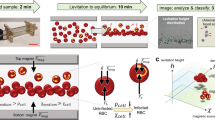Abstract
The magnetic method has been previously utilized to concentrate Plasmodium-infected erythrocytes without any significant influence on the viability of the parasite. We attempted, in this study, to concentrate and synchronize cultivated P. falciparum via the magnetic method. The results of this study showed that the magnetic method effectively synchronized and concentrated P. falciparum with finer demarcation capacity in the erythrocytic asexual cycle of the parasite than currently available synchronization methods. Concentration and synchronization by the magnetic method proved most effective when schizonts were dominant. Therefore, it proved necessary to enhance the synchronization efficiency of the magnetic method by first applying the method currently in use, which renders schizonts dominant. Our study also showed that the intrinsic life cycle of erythrocytic P. falciparum was slightly longer than 48 h observed in natural infection cases, and that the length of the intrinsic life cycles between various P. falciparum strains differed slightly.



Similar content being viewed by others
References
Adrysiak PM, Collins WE, Campbell GH (1986) Concentration of Plasmodium ovale—and Plasmodium vivax—infected erythrocytes from nonhuman primate blood using Percoll gradients. Am J Trop Med Hyg 35:251–254
Artavanis-Tsakonas K, Riley EM (2002) Innate immune response to malaria: rapid induction of IFN-gamma from human NK cells by live Plasmodium falciparum-infected erythrocytes. J Immunol 169:2956–2963
Bogitsh BJ, Carter CE, Oletmann TN (2005) Blood and tissue protozoa II: Human malaria. In: Bogitsh BJ, Carter CE, Oletmann TN (eds) Human parasitology, 3rd edn. Elsevier, San Diego, pp 129–152
Heidrich HG, Mrema JEK, Jagt DLV, Reyes P, Rieckmann KH (1982) Isolation of intracellular parasites (Plasmodium falciparum) from culture using free-flow electrophoresis: separation of the free parasites according to stages. J Parasitol 68:443–450
Hensmann M, Kwiatkowski D (2001) Cellular basis of early cytokine response to Plasmodium falciparum. Infect Immun 69:2364–2371
Hui GSN, Palmer KL, Siddiqui WA (1983) Synchronization of Plasmodium falciparum in continuous in vitro culture: use of colchicines. Am J Trop Med Hyg 32:1451–1453
Inselburg J, Banyal HS (1984) Plasmodium falciparum: synchronization of asexual development with aphidicolin, a DNA synthesis inhibitor. Exp Parasitol 57:48–54
Krogstad DJ (2000) Plasmodium Species (Malaria). In: Mandell GL, Bennett JE, Dolin R (eds) Mandell, Douglas and Bennett’s Principles and Practice of Infectious Disease. 5th edn. Churchill Livingstone, Philadelphia, pp 2817–2831
Lambros C, Vanderberg P (1979) Synchronization of Plasmodium falciparum erythrocytic stages in culture. J Parasitol 65:418–420
Lelievre J, Berry A, Benoit-Vical F (2005) An alternative method for Plasmodium culture synchronization. Exp Parasitol 109:195–197
Paul F, Roath S, Melville D, Warhurst DC, Osisanya JOS (1981) Separation of malaria-infected erythrocytes from whole blood: use of a selective high-gradient magnetic separation technique. The Lancet 11:70–71
Pfaller MA, Krogstad DJ, Parquette AR (1982) Plasmodium falciparum: stage-specific lactate production in synchronized cultures. Exp Parasitol 54:391–396
Scragg IG, Hensmann M, Bate CAW, Kwiatkowski D (1999) Early cytokine induction by Plasmodium falciparum is not a classical endotoxin-like process. Eur J Immunol 29:2636–2644
Trang DTX, Huy NT, Kairu T, Tajima K, Kamei K (2004) One-step concentration of malarial parasite-infected red blood cells and removal of contaminating white blood cells. Malaria J 3:7–13
Trigg PI, Kondrachine AV (1998) The current global malaria situation. In: Sherman IW (ed) Malaria: parasite biology, pathogenesis and protection. ASM, Washington DC, pp 11–22
Vogt A, Pettersson F (2004) Selection of trophozoites by using magnetic cell sorting (MACS). In: Ljungström I, Perlmann H, Schlichtherle M, Scherf A, Wahlgren M (eds) Methods in malaria research. 4th edn. MR4/ATCC, Manassas, pp 31–33
Acknowledgments
This study was supported by a grant from the Korea Centers for Disease Control and Prevention (2007-E00032-00).
Author information
Authors and Affiliations
Corresponding author
Additional information
Sun-Young Ahn and Mi-Young Shin contributed equally to this work.
Rights and permissions
About this article
Cite this article
Ahn, SY., Shin, MY., Kim, YA. et al. Magnetic separation: a highly effective method for synchronization of cultured erythrocytic Plasmodium falciparum . Parasitol Res 102, 1195–1200 (2008). https://doi.org/10.1007/s00436-008-0893-8
Received:
Accepted:
Published:
Issue Date:
DOI: https://doi.org/10.1007/s00436-008-0893-8




